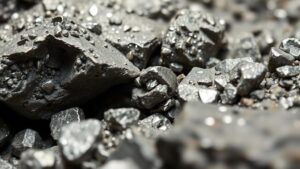Identifying Heavy Mineral Deposits in Coastal Beach Sands
Identifying Heavy Mineral Deposits in Coastal Beach Sands
Coastal beach sands are not just alluring landscapes; they also serve as significant geological records and economic resources. Among the various components found within these sands, heavy minerals play a crucial role in various industrial applications, including ceramics, electronics, and metallurgy. This article explores how to identify heavy mineral deposits in coastal beach sands, facilitating their potential exploitation and study.
Understanding Heavy Minerals
Heavy minerals are defined by their density, typically greater than 2.85 grams per cubic centimeter. include minerals such as zircon, ilmenite, rutile, and monazite. These minerals often exhibit unique physical and chemical properties, making them valuable for industrial uses. For example, zircon is extensively used in the production of ceramics and in the nuclear power sector due to its high melting point and low thermal conductivity.
The Geological Significance of Heavy Minerals
The presence of heavy minerals in beach sands is primarily influenced by weathering processes, transportation dynamics, and sedimentary environments. are usually derived from the erosion of igneous and metamorphic rocks, transported via rivers, and deposited in coastal environments through wave action. Understanding these processes aids in the identification of potential heavy mineral deposits.
Methods for Identifying Heavy Mineral Deposits
The identification of heavy mineral deposits in coastal beach sands involves several techniques, each providing unique insights
- Field Sampling: Systematic collection of sand samples from various locations across the beach. The samples should be taken at different depths to account for stratification. For example, research conducted on the Atlantic coast of the United States demonstrated that heavy mineral concentrations vary significantly from the high tide line to the dunes.
- Laboratory Analysis: After sampling, laboratory analyses such as sieving, magnetic separation, and heavy liquid separation can be employed to isolate heavy minerals. In a case study from Australia, these methods allowed researchers to identify rich deposits of ilmenite and zircon.
- Mineralogy and Geochemistry: Techniques such as X-ray diffraction (XRD) and scanning electron microscopy (SEM) are used to characterize the mineralogy and chemical composition of heavy minerals. This helps in distinguishing between similar heavy minerals and assessing their suitability for industrial applications.
Factors Influencing Heavy Mineral Concentration
Several environmental factors affect the abundance and distribution of heavy minerals in coastal sands:
- Wave Energy: High-energy environments tend to winnow away lighter minerals, concentrating heavier ones. Research in the Caribbean demonstrated that strong wave action led to pockets of high magnetic minerals, including magnetite.
- Fluvial Contributions: Rivers can introduce significant quantities of heavy minerals to coastal zones during floods. For example, heavy mineral sands along river outlets in South Africa have been linked to sedimentation patterns from upstream mining activities.
- Human Activity: Coastal mining and construction can alter natural sediment dynamics, influencing the distribution of heavy minerals. Studies have indicated that dredging operations near beach environments can lead to the redistribution of heavy mineral deposits.
Case Studies
Multiple case studies exemplify the successful identification of heavy mineral deposits in coastal environments:
- Mindanao, Philippines: Detailed assessments of coastal sands revealed considerable ilmenite reserves. Sample analysis indicated concentrations exceeding 30% in certain locations, prompting further exploration.
- Western Australia: The differentiation of heavy mineral assemblages using mineralogical techniques provided insights into high-value regions for zircon and rutile extraction, leading to increased mining investments in these areas.
Real-World Applications
Identifying heavy mineral deposits in coastal beach sands has numerous practical implications, including:
- Resource Management: The sustainable management of mineral resources can greatly benefit local economies through responsible extraction practices.
- Environmental Protection: Understanding the geology of coastal sands aids in the identification of sensitive areas that need protection from mining and other disruptive activities.
- Geological Research: Heavy minerals serve as indicators for sedimentary processes and can help reconstruct historical geological events.
Actionable Takeaways
For practitioners and stakeholders interested in heavy mineral deposits, the following steps can be taken:
- Conduct systematic sampling campaigns across diverse beach environments.
- Use modern laboratory techniques for precise mineral identification and characterization.
- Stay informed about local geological and environmental regulations to ensure sustainable practices.
In summary, identifying heavy mineral deposits in coastal beach sands is an intricate process combining geological understanding, analytical methods, and practical applications. The potential for these resources is substantial, and as research continues to evolve, the benefits will extend to various industries and environmental stewardship initiatives.


